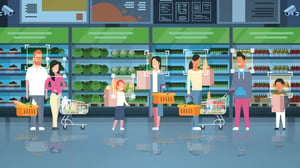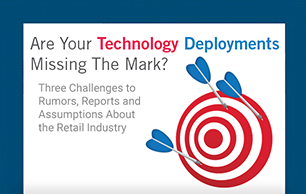 RIS News and Progressive Grocer partnered to release the 2019 Grocery Tech Trends Study, a fascinating look at grocers’ pursuit of the digital transformation, technology investment priorities and the future of grocery shopping.
RIS News and Progressive Grocer partnered to release the 2019 Grocery Tech Trends Study, a fascinating look at grocers’ pursuit of the digital transformation, technology investment priorities and the future of grocery shopping.
There’s an interesting split between investment in critical “catch-up” technologies that are necessary if grocers want to catch up with other retailers that have invested in omnichannel retailing, which has largely eluded grocers until now. However, Millennials and Gen Z shoppers are pushing grocers to offer the same fully omnichannel experience as other retailers, forcing investments in technologies from e-commerce to price management to remain competitive. In fact, 91 percent of grocers said that omnichannel customer expectations have increased over the last five years with 43 percent saying they have increased greatly.
However, beyond the fundamentals, grocers are investing in technologies to monitor customers. From shopper tracking to location-based monitoring, customer monitoring seems to be highly prized among grocers and the technologies on which they are placing their bets for the future. Why are grocers so focused on understanding their shoppers? For some context, it’s important to understand the grocery segment and the unique challenges facing this retail segment.
Traditionally the home of the obligatory once weekly or once monthly shopping trip, grocers served a stable and predictable market for the most part, never to become obsolete. But today’s consumer is different and, flanked by changing dining and retail habits, grocers have been pressed for change or risk falling behind and losing out to replacement competitors in some of their most profitable areas. From QSR to take-out, Amazon Prime and big box retailers, grocers face more competition than ever. Who knows what the future of grocery looks like or what features will make it compelling? Consumers themselves may not even know and in-store monitoring gives grocers the information they need to find out.
Time-starved consumers are drawn to prepared foods and quick pick-ups. They may log into their phones to quickly order items from home that they know they will need, show up after work for pick-up, drop by the pharmacy to fill a prescription and then grab a pre-prepared meal for dinner. Grocers need to make the most of their in-store real estate, configuring it for convenience and quick access to items that AI say are popular among hungry, busy shoppers. Grocers will have to think quick and react quickly, possibly reconfiguring stores and displays on the fly as tastes and seasons change. What activities, smells or events keep people in the store? From cooking demonstrations to a free coffee bar and/or samples, grocers are having to try tactics and measure their effectiveness with in-store monitoring to understand what’s next.
In the interest of ensuring convenience and speed, grocers must also leverage in-store monitoring to ensure minimum wait times at service counters, registers (while they last!) and feature displays. A recent study indicated that an astounding 85 percent of grocery shoppers said the checkout experience/wait time was an important part of their decision about where to shop.
Technology will not only enable the next generation grocery shopping experience, but will also help grocers determine the precise demands for the optimal #CX. For those grocers that have not considered investing in the technologies to take them to the next level, the time is now.




